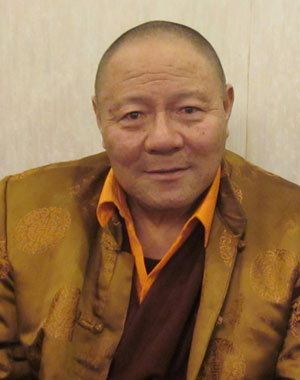|
 |
|
A mugshot of the Living Buddha [Photo/China Daily] |
"When we dug a body out of the rubble, we found it was a mother, and beneath the hunched corpse was a baby's body. She tried to protect the baby with her own body," he said. "In the first few days after the earthquake, I couldn't hold back my tears as monks and soldiers of the People's Liberation Army dug out the bodies. I tried to comfort survivors. It was a terrible time but people came and worked together, regardless of ethnicity or religion."
Rinchen, 67, is one of the two living Buddhas in Saiba Monastery, Yushu, one of 87 Tibetan monasteries damaged in the earthquake, among which, the best known were Trangu, Gyegu and Renyak. Trangu Monastery has a history of 700 years.
"It was a great loss. We thought it would take us a long time to rebuild homes, monasteries, roads and other infrastructure. We knew the government would support us but we were surprised to find that the support was so tremendous," he said.
In three years the central government granted more than 990 million yuan ($164 million) to rebuild or repair damaged temples and religious buildings, including the 87 Tibetan monasteries and a Buddhist college.
"It means so much to us since all Tibetan people believe in Buddhas. After the earthquake, over a period of 65 days, I went to a lot of places to help with funerals. When people saw me, they thanked me for coming to see them and told me: ‘Living Buddha Saiba, my parents, sisters and brothers died, but I survived,' and I cried with them and tried to give them any small comfort I could," he said.
The rebuilding work has made tremendous progress. Almost all the monasteries are ready for routine religious activities and monks have moved in. Homes have been built. Almost all infrastructure work has been completed.
"The progress is amazing. It's like the whole prefecture has jumped 50 years forward in just three years. We are very grateful to all the people who have helped and supported us, people from home and abroad, and all religious communities who pray for us," he said.
In Saiba Monastery, Rinchen has a 2,000 square-meter museum, and a personal collection of antiques that display the culture, tradition and history of people in Tibet.
"This place is for the younger generation to learn, for the middle-aged to refer to, and for older people to cherish the memory of the past," he said.
The earthquake in 2010 killed more than 2,200 people in Yushu, an area populated predominantly by ethnic Tibetans. There were thousands of monasteries in the region before the quake. The number of monks, nuns and other religious personnel was estimated at 23,000, local government data showed.
The economic losses of the monasteries and in-house religious relics was estimated to be around 750 million yuan.
Contact the writer at yangyangs@chinadaily.com.cn
